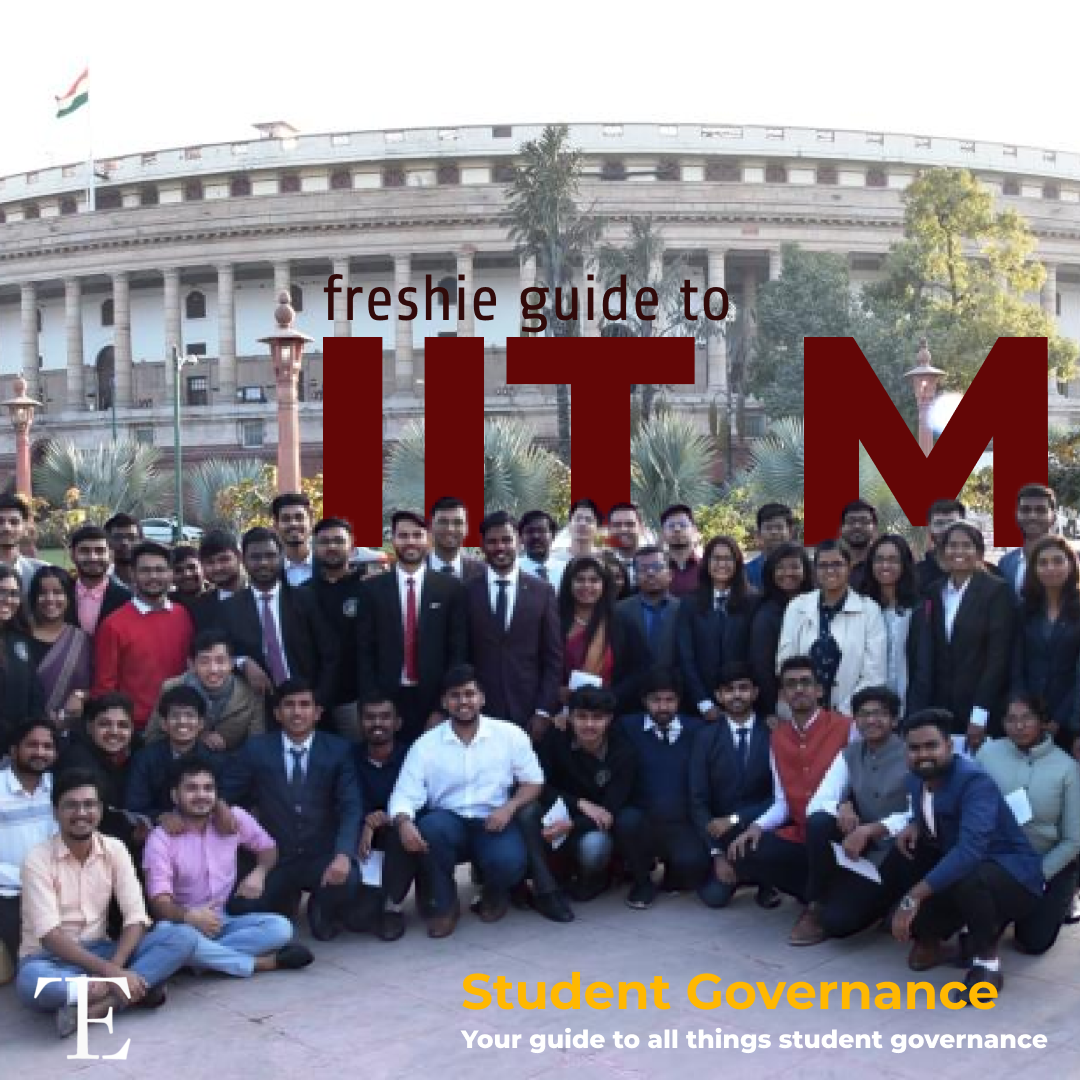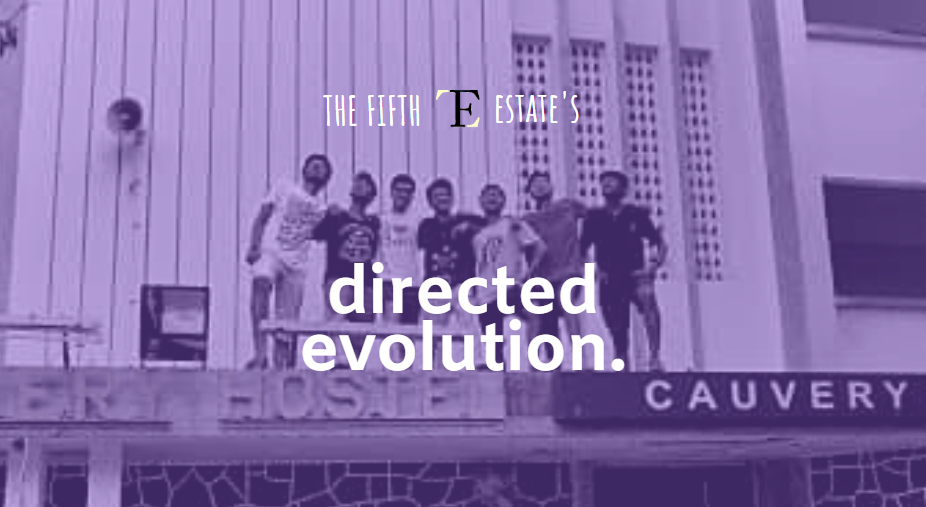Kudos on making it to one of the most coveted institutes of India. Surely, by now, you must have heard about the exhilarating wonders of campus life – the competitions, the events, the unending streams of clubs and the bedazzling cultural & tech fests. However, behind this seemingly hodge-podge world of limitless organizations and activities, stands a vast sturdy structure preventing them from falling into utter chaos. This is the IIT Madras Student Government. IIT Madras is one of the few institutes in the country that provides an inclusive and constructive atmosphere for the students to voice their opinions through a democratic governance system that is accessible to each and every student in the institute. Through the vivacious campaigns of the election seasons to the heated debates over Smails and town-hall meetings, the student government is a fest in itself celebrating the democratic spirit of the student community.
So, let’s take a tour through the bodies and structures of IIT Madras Student Government.
The Co(insti)tution
The basis of the student governance was founded in our very own constitution formed in 1982 by a group of democratically spirited students who realized the importance for a transparent and representative campus for the students’ holistic welfare. Consequently, the preamble proclaims the student government to be a democratic representative system, endeavoring to cultivate an atmosphere of tolerance, trust, and harmony.
The constitution starts by proclaiming the General student Body (GSB), which consists of all registered students of the institute, to hold the supreme power in the governmental setup and all student bodies. This means that all students in the institute are part of the GSB and all political power vested in the authorized bodies are to be derived from the GSB.
It also defines the jurisdiction and types of different student government organizations. Organizations that come under the purview of the executive, legislative council or the constitutional commission are called the Student Government Associated Organizations (SGAO), and any student member of a student organization who possesses executive or decision-making power within that organization possess a Position of Responsibility (PoR; something which you will be scrambling for pretty soon).
The constitution then proceeds to lay out the division of power among different bodies of the student government, the procedure for election and financing and division of budget among the bodies.
The Constitution divides the student government into 3 bodies-
Implementing the Chaos: The Executive
Most of the teams and SGAOs you are going to come across, fall under the purview of the Executive, the most visible face of the student government. It is responsible for managing day-to-day student affairs as well as implementation of the policies of the Student Legislative Council (SLC). The executive is divided into 10 executive councils each responsible for a different part of students’ affairs and headed by elected representatives. Moreover, each council has its own executive committee to assist the elected representatives with its functions. Here are 10 councils and their functions:
Students General Secretary (SGS): The SGS is an elected representative and his/her primary responsibility is to bridge the gap between the GSB and SLC and represent the views of GSB to the senate. It represents the students in the tendering processes for student facilities and amenities such as hospital, transport, canteen and security. The SGS also organizes and monitors committees which do not fall under the purview of other Executive Council members. The executive committee of the SGS endeavors to solve the issues of the student community and to come up with new initiatives to improve its quality of life.
Academic Affairs Secretary (AAS): The role of AAS is to represent the views of the students from taught programs on academic matters to the Board of Academic Courses and the Senate. It looks after the academic and career interests of the GSB and ensures the functioning of all the centralized academic facilities (such as the library) available to GSB. Consequently, the AAS is one of the heads for Placement Development Cell (IPR) and Career Development Cell (CDC). It also coordinates the activities of executives at the department level (Department council and Department legislators) for each department on common academic matters.
Co-Curricular Affairs Secretary (CoCAS): The CoCAS is responsible for planning and organizing all the co-curricular activities for the students. Prestigious teams such as Shaastra, E-cell, Center for innovation (CFI), and Nirmaan are handled by this council.
Cultural Affairs Secretary (CAS Literary and CAS Arts): All the literary/arts/social based cultural competitions and events in the institute are conducted by the CAS’s. This includes the cultural fests like Saarang and all the cultural clubs that fall under Sangam (Currently the 17 clubs). This also makes CAS responsible for the selection and training of the cultural and institute contingent. It is also in-charge of conducting inter-hostel competitions such as LitSoc and organizing Inter-IIT and other inter-collegiate events.
Research Affairs Secretary (RAS): The RAS represents the views of the students from research programs on matters related to academic research to the Board of Academic Research and the Senate. These include the research programme, the curriculum, teacher, guide and course feedback, and postgraduate research. It is closely coordinated with AAS as co-head of CDC and IPR. It is also involved in coordinating functioning of all the centralized facilities of academic nature, such as the Library, the P. G. Senapathy Computer Centre, the Placement Office etc. along with the Academic Affairs Secretary.
Hostel Affair Secretary (HAS): HAS is responsible for the redressal of issues regarding the general maintenance of the hostels. It is the student body representative to the hostel management in all hostel matters such as procurement of equipment, supplies and other amenities for hostels and messes. He/ She is also the ex-officio student head of Mess Monitoring and Control Committee (MMCC) and the Committee for Monitoring of General Facilities of Students(CMGFS).
International and Alumni Relations Secretary (IAR): The IAR Secretary coordinates with the Office of International & Alumni Relations to maintain and improve the Institute’s relations with its alumni and organize avenues for the students to interact with and benefit from the Institute’s alumni network. It is responsible for maintaining and improving the Institute’s public image by managing the Institute’s public relations, including its interactions with the external media and its online and social media presence. Thus teams such as Chennai36, IITM TV and Alumni Relation Cell (ARC) also come under its purview.
Institute Sports Secretary: The sports secretary looks after all issues regarding sports activities of the students. It is responsible for the assistance of the Physical Training Instructors, for the selection of Institute Teams, coaching and organizing inter-hostel and inter-collegiate matches as well as procurement of sports equipment and maintenance of facilities.
Speaker of the Student Legislative Council(SLC): The SLC is present as a non-voting council.
The Policy Makers: Student Legislative Council
All legislative duties of the student government are carried out by the legislative council. This includes bills (policies that are to be implemented by the executives), resolutions (Official recommendations by the SLC) and constitutional amendments. It has the mandate to enforce the Students’ Constitution and enact legislation by making rules and regulations as may be deemed necessary and proper for the execution of its responsibilities to fulfill the constitution’s mandate. It is also the sole disbursing authority for all funds collected from the students and earmarked for student welfare such as the funds held in the Gymkhana Activities Account. The SLC has a Mandate to enforce the Students’ Constitution and enact legislation by making rules and regulations as may be deemed necessary and proper for the execution of its responsibilities to fulfill its mandate;
The SLC is composed of a total of 58 elected legislators. These include:
- 1 Hostel Legislator from each hostel.
- 1 Under-graduate Department Legislator (Academic) representing the taught programs of each department.
- 1 Post-graduate Department Legislator (Research) representing the research programs of each department.
- 4 Legislators representing postgraduate students pursuing two year postgraduate courses in engineering/technology.
Each of these legislators represent their respective electorates and the welfare of the students. The SLC is presided over by the speaker who is elected by the Legislators to Convene, conduct, and moderate the meetings of the SLC which are regularly and publicly held.
Bodies under the SLC
- Legislative committees: These committees act as a link between the SLC , the Executive Council, and the GSB. They review the actions of the executive to help maintain accountability and compile the views of executive council and GSB to present a monthly report to the SLC. There are two types of legislative committees
- Standing committees: These are permanent committees with a prescribed area of jurisdiction.They check the feasibility of the agenda of the executive wing and ensure their proper implementation in the best interest of the GSB. A standing committee exists for each council of the executive along with additional standing committees for financial affairs, health and hygiene and women’s affairs.
- Ad-Hoc committees: Thecse are temporary committees established to deal with matters in need of immediate/urgent attention. The mandate and duration for which the committee shall work is specified by the SLC at the time of constitution
Teams under the Speaker
1. Public Policy Club(PPC): PPC is a newly constituted club under the SLC speaker which aims to actively engage the student community in the discourse on governance and campus and create a conducive political environment for intellectually stimulating debates on the ongoing policy issues in the campus.
2. The Secretariat: It is in charge of looking after the publicity and facilities requirements of the Student Legislative Council and its committees.
The Home Makers: Hostel Council
Each hostel has its own hostel student body that formulates policies and budgets for their own hostels. Like the GSB, the Hostel student Body (HSB) comprises the hostel’s residents. The HSB of each hostel elects a Hostel Council for their particular hostel which is the Executive body of that hostel responsible for policy formulation and implementation. The Hostel council comprises of the following elected posts:
- Hostel Legislator
- General Secretary
- Health and Hygiene Secretary
- Literary Secretary
- Social Secretary
- Sports Secretary
- Technical Affairs Secretary
In addition, it also consists of the Warden and the Assistant Warden. The hostel council holds regular meetings in attendance of the warden to consider proposals for the improvement of the functioning of the hostels.
The Department Council
There are, in total, 16 academic departments in IIT Madras (17, including the newly launched Department of Medical Science and Technology). The student body of each department comprises its department student body (DSB). The DSB of each department elects its own department council consisting of two department legislators (Academic and Research), a research counselor and a class representative from each batch. The Department council conducts the general body meetings at least once a semester to discuss the issues of its interest, to pass policies, to review the performance of the members of the Department Council, and to make amendments to the Department Charter.
The Court of Law: Students’ Ethics and Constitution Commission (SECC)
SECC is the regulatory body of IIT Madras similar to the judicial wing of the government. It consists of the Faculty advisor of the SECC, Chief SECC Commissioner and 2 Commissioners. There also exists an SECC Secretariat to assist the SECC in its operations. The responsibilities of SECC include:
- Interpretation of the constitution, constitutional amendments and all legislation passed in the SLC
- Addressing any controversies or disputes involving any member of the GSB and/or SGAOs
- Charging violations of the constitutional principles or laws and legislation passed by the SLC
- Conducting free and fair elections. The SECC acts as the Student Election Commission (SEC) during the period of elections.
Any member of the GSB has the right to file a Public Interest Litigation (PIL) with SECC on any issue that they feel affects the welfare of the institute which the SECC hears at its earliest and comes up with recommendations to the concerned authorities to take action based on the PIL. The SECC also has the right to issue disciplinary warnings or the suspension of an individual and to dismiss elected officials upon violation of the constitution. Thus SECC is an autonomous body capable of checking the powers of the executive and legislative members.
Other Constitutional bodies
- Financial Accountability Committee (FAC): The Financial Accountability Committee is envisaged as the primary student body for scrutinizing and maintaining the financial records of student organizations of IIT Madras. FAC is the financial ombudsman of IIT Madras.
- Gender Sensitisation and Minority Welfare Committee (GSMWC): It is responsible for effective establishment of the basic human right of equality and guarantee against sexual and racial harassment and abuse on the campus.
- Yours Truly: The Fifth Estate (T5E) is the official media body of IIT Madras. It acts as an effective tool to bridge the gap between the GSB and SLC through independent, unbiased and impartial reporting
Here it is, one of the most powerful and comprehensive organizations in the insti (Excluding the campus monkeys, ofcourse). This guide has attempted to shed a brief light on the fundamental aspects of student governance, from understanding its purpose and structure to exploring the key responsibilities and opportunities it presents, with the aim to inculcate the democratic spirit of the insti in its newest junta.
Edited by Meenakshi Anoop





